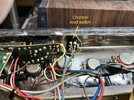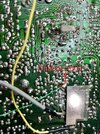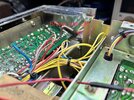i picked up a Cobra 2000 GTL knowing it wasn’t tested but for the price I figured the speaker alone was worth the purchase. Did a normal once over, correct fuse, nothing inside burnt… but I did find 2 loose parts inside, never a good thing. I included a few pics of what I see inside. It looks to have a channel mod with 3 position switch in the aux spot. One wire is off, not a big deal if I get it working I am removing the mod. To my surprise it receives great but no TX.
here are some pics on the inside.
here are some pics on the inside.
Attachments
-
 IMG_0385.png7.5 MB · Views: 13
IMG_0385.png7.5 MB · Views: 13 -
 IMG_0381.jpeg351.9 KB · Views: 12
IMG_0381.jpeg351.9 KB · Views: 12 -
 IMG_0382.png8.2 MB · Views: 14
IMG_0382.png8.2 MB · Views: 14 -
 IMG_0384.jpeg2.1 MB · Views: 14
IMG_0384.jpeg2.1 MB · Views: 14 -
 IMG_0373.jpeg1.2 MB · Views: 14
IMG_0373.jpeg1.2 MB · Views: 14 -
 IMG_0377.jpeg3.1 MB · Views: 14
IMG_0377.jpeg3.1 MB · Views: 14 -
 IMG_0374.jpeg1.5 MB · Views: 14
IMG_0374.jpeg1.5 MB · Views: 14 -
 IMG_0375.jpeg1.3 MB · Views: 13
IMG_0375.jpeg1.3 MB · Views: 13 -
 IMG_0383.jpeg406.3 KB · Views: 12
IMG_0383.jpeg406.3 KB · Views: 12 -
 IMG_0376.jpeg1 MB · Views: 13
IMG_0376.jpeg1 MB · Views: 13

